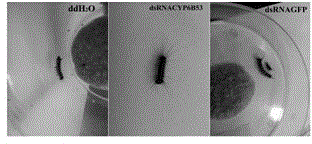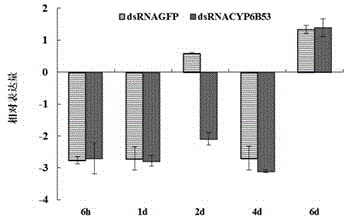Lymantria dispar linnaeus CYP6B53 gene dsRNA and application thereof in nuisanceless control
A technology of gypsy moth and gene, applied in the field of application in the control of Asian gypsy moth
- Summary
- Abstract
- Description
- Claims
- Application Information
AI Technical Summary
Problems solved by technology
Method used
Image
Examples
Embodiment 1
[0026] Example 1 : Gypsy moth cytochrome CYP6B53 Gene full-length cloning
[0027] The gypsy moth cytochrome CYP6B53 gene has a nucleic acid sequence of 1728 bp (SEQ ID No.1), an open reading frame of 1518 bp, encoding 506 amino acids (sequence shown in SEQ ID No.2), a molecular weight of 57.72 kDa, and a theoretical isoelectric point PI is 8.76, which is a basic protein.
[0028] Total RNA was extracted from Gypsy moth, using the reverse transcription kit PrimeScript TM RT reagent Kit (TaKaRa) synthesized the first strand of cDNA, and used the first strand of cDNA as a template to design primers on both sides of the gene coding region sequence according to the transcriptome sequence of gypsy moth larvae (forward primer: 5'- ATGTTGTCAATTTATTTACCTATATTTCTCATAGTAGC -3' ; reverse primer: 5'-ATTTGAAGATTTCCTCGGAACAAGTCTTACGTGAATCCCC-3'). Reaction system: 5×PrimeScript buffer 2 μL, PrimeScript RT Enzyme Mix I 0.5 μL, Oligo d(T) primer (50 μM) 0.5 μL, Random 6 mers (100 μM...
Embodiment 2
[0029] Example 2 : Gypsy moth CYP6B53 Gene dsRNA Synthesis
[0030] According to the full length of CYP6B53 gene of Gypsy moth cloned in Example 1, design and synthesize CYP6B53 gene dsRNA forward primer (5'- ATGTTGTCAATTTATTTACCTATATTTCTCATAGTAGC -3') and reverse primer (5'- ATTTGAAGATTTCCTCGGAACAAGTCTTACGTGAATCCC -3') to amplify the fragment The length of the sequence is 594 bp, and the dsRNA of the CYP6B53 gene is obtained through an in vitro dsRNA synthesis kit.
[0031] The specific synthesis process is that a 20 bp T7 promoter sequence is added to the 5' end of each specific primer, and GFP is used as a control group. The target band was amplified by PCR, and the reaction program was: 94°C for 3 min; 94°C for 30 s, 60°C for 30 s, 72°C for 1 min, 35 cycles; 72°C for 7 min, and the amplified product was confirmed by electrophoresis. Synthesize dsRNA as a template (refer to the MEGAscript RNAi Kit kit instructions), detect the concentration of dsRNA with a UV ...
Embodiment 3
[0032] Example 3 : Gypsy moth CYP6B53 Detection of gene silencing effects
[0033] The dsRNA (1 μg) of the CYP6B53 gene and GFP gene synthesized in Example 2 was microinjected into the 3rd instar larvae of the gypsy moth, and the lively 3rd instar larvae were selected at 6, 24, 48, 96, and 144 h respectively, and the RNeasy Mini animal was used to Tissue Total RNA Extraction Kit (Qiagen) was used to extract total RNA using PrimeScript TM The RT kit (TaKaRa) synthesized the first strand of cDNA, which was used as a template, and the expression level of CYP6B53 gene after injection was detected by fluorescent quantitative RT-PCR. The expression level of CYP6B53 gene in 3rd instar larvae injected with dsRNA was as follows: figure 2 As shown, the results indicated that the injection of dsRNA of exogenous control gene GFP into gypsy moth larvae would affect the expression of CYP6B53 gene. Compared with the control GFP gene, the CYP6B53 gene silencing effect was higher t...
PUM
| Property | Measurement | Unit |
|---|---|---|
| molecular weight | aaaaa | aaaaa |
Abstract
Description
Claims
Application Information
 Login to View More
Login to View More - R&D
- Intellectual Property
- Life Sciences
- Materials
- Tech Scout
- Unparalleled Data Quality
- Higher Quality Content
- 60% Fewer Hallucinations
Browse by: Latest US Patents, China's latest patents, Technical Efficacy Thesaurus, Application Domain, Technology Topic, Popular Technical Reports.
© 2025 PatSnap. All rights reserved.Legal|Privacy policy|Modern Slavery Act Transparency Statement|Sitemap|About US| Contact US: help@patsnap.com



